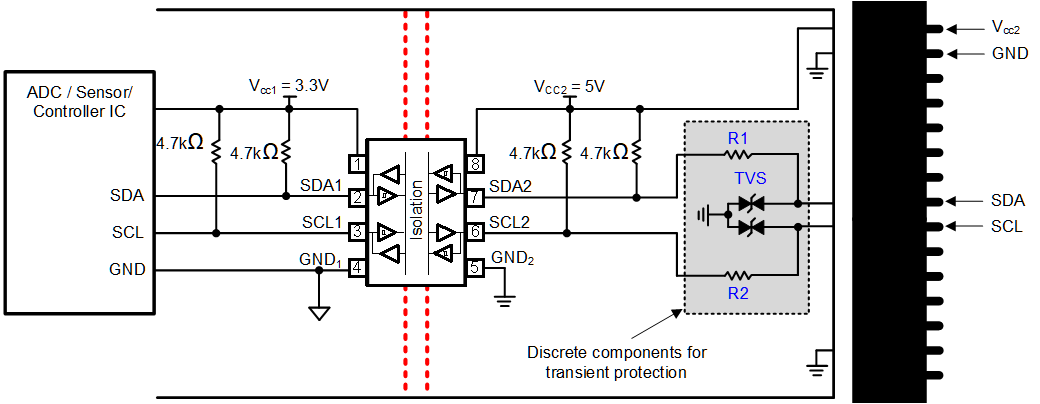SLLA548A March 2021 – March 2022 ISO1540 , ISO1541 , ISO1640 , ISO1641 , ISO1642 , ISO1643 , ISO1644
- Trademarks
- 1 What is Isolated I2C?
- 2 What is Hot Swap?
- 3 Benefits of Hot-Swappable Isolated I2C
- 4How Hot-Swap Capability is Achieved Today
- 5Robust Communication With the Built-in Hot-Swap Feature of the ISO164x
- 6Simplified System-Level ESD Protection Design With ISO164x
- 7Conclusion
- 8References
- 9Revision History
6 Simplified System-Level ESD Protection Design With ISO164x
In systems featuring ports or removable nodes, PCBs are exposed to the outside world through connectors, leaving them susceptible to damage from Electrostatic Discharge (ESD). These system-level ESD events are almost expected to happen on the exteriors of any product that has direct or indirect contact with humans or external items. Therefore, nodes that are typically susceptible to ESD events are terminals and connections, like power lines (AC, DC, or battery) and communications lines (like RS-485, CAN, or I2C), and they are required to withstand ESD stress levels defined by the IEC 61000-4-2 (referred to as IEC ESD) standard. The necessary level of IEC ESD protection is different from application to application.
Any end application or equipment can expect ESD events whether they are powered-on or unpowered, so modules and connection points should be protected against IEC ESD. The industry standard is: wherever there are exposed ports, those ports need to have IEC ESD protection. For example, I2C and RS-485 communication ports are typically protected against IEC ESD using external protection components near the connector as shown in Figure 6-1.
 Figure 6-1 Discrete
Transient Protection Against IEC ESD for
I2C
Figure 6-1 Discrete
Transient Protection Against IEC ESD for
I2CSince external TVS diodes usually clamp voltage above the maximum operating voltage (VCC) of devices, resistors are included in the previous solution to drop voltage further and protect a device without damaging it, while higher resistances degrade the integrity of a bus.
Enhanced ESD protection cells are designed on the I2C bus pins of ISO164x to support up to 10-kV HBM ESD on side 1 of the device and 14-kV HBM ESD on side 2. This integrated protection replaces the discrete components traditionally necessary to protect I2C devices against IEC ESD, and the integrated ESD protection of the ISO164x makes system design easier and more reliable by removing the need for both TVS diodes and large resistors for ESD protection, complementing its I2C hot-swap abilities with the industry’s-strongest local IEC ESD performance. The I2C bus pins on side 2 are designed to withstand a same-side IEC ESD strike of 8-kV when the device is unpowered, improving robustness and system reliability in hot-swap applications.